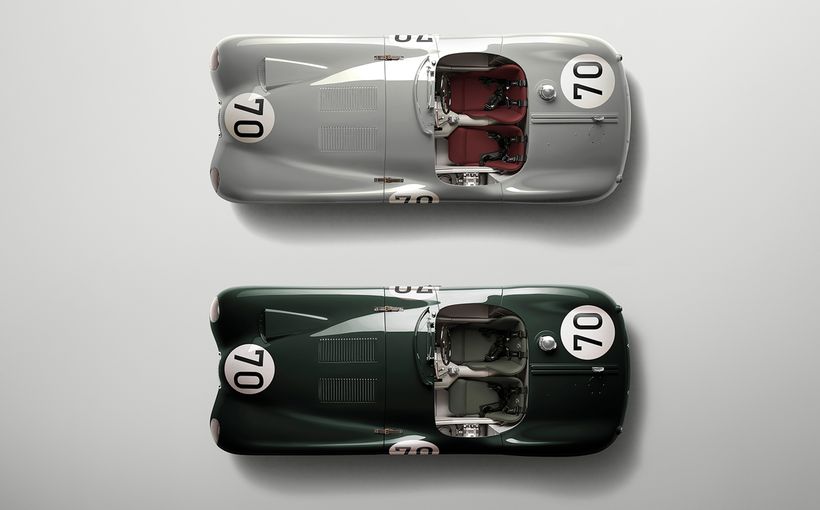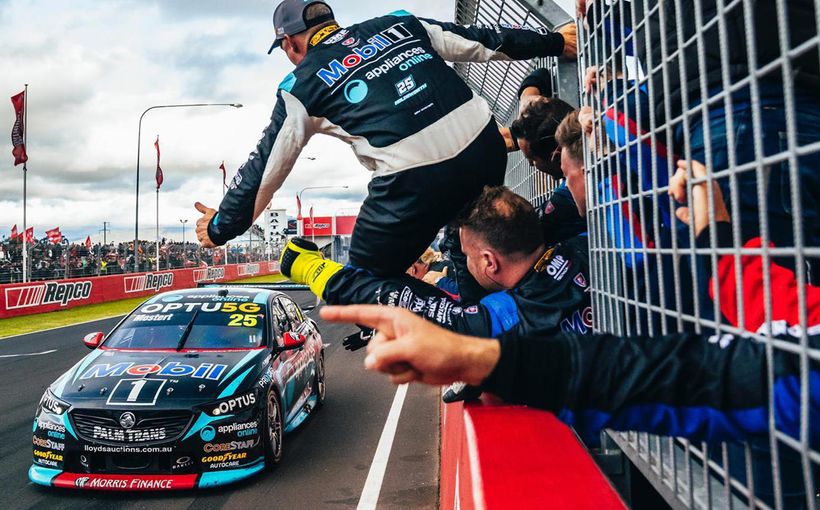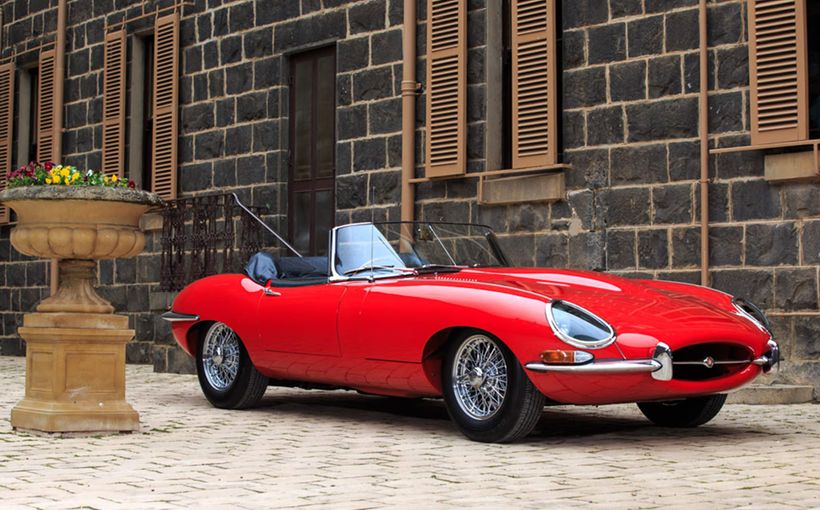1985 Bathurst 1000: Attack of the Tom Cats

The 1985 Bathurst 1000 was one of the most exciting and memorable in the history of The Great Race, thanks largely to Tom Walkinshaw Racing and its trio of howling V12 Jaguar XJ-S coupes that delivered a popular win for the British team.
The burly Scotsman was determined to extract his revenge on the Mountain after failing to get off the start line the previous year, due to a clutch failure in the locally developed XJ-S he shared with car owner and Bathurst winner John Goss.
On his return to Bathurst in ‘85, Walkinshaw ensured nothing was left to chance, armed with the same cars that had blitzed arch rival BMW in the 1984 European Touring Car Championship (ETCC).
The professionalism of the TWR Jaguar operation was hard to fault, displaying all the discipline and experience of a well-drilled factory team battled-hardened by three seasons of intense competition in Europe.
Jaguar’s Bathurst blitz was the final chapter in a story that had started three years before when TWR and the famous British car maker formed a partnership that was clearly destined for greatness.

How Tom turned the Jaguar XJ-S into a winner
Tom Walkinshaw Racing opened its doors in 1976 at Kidlington, Oxfordshire. TWR quickly built a reputation for delivering winning results following a successful partnership with Mazda.
An RX-7 driven by Win Percy won British Touring Car Championship titles in 1980-81 and Walkinshaw was also a member of the RX-7 driving squad that scored a resounding victory for Mazda in the rain-soaked Spa 24 Hour race in 1981.
Keen to grow his racing empire, Walkinshaw sensed an opportunity to compete in the 1982 ETCC which had been given a new lease on life following a decision to replace the FIA’s unpopular Group 2 rules with new Group A regulations.
Being a proud Brit, Walkinshaw did his sums on what UK-built cars might be competitive under the new rules, which were designed to provide the widest variety of cars with the best chance of being competitive across a number of classes.
Put simply, Group A’s sliding scale of performance matched a car’s cubic engine capacity (cc) with a maximum fuel tank size (litres), tyre width (inches) and minimum weight (kgs). Modifications to engine, drivetrain and suspension kept a reasonable limit on how far race teams could stray from the showroom products.
Walkinshaw worked out that Jaguar’s 5.3 litre V12-powered XJ-S coupe had all the right ingredients to be a formidable Group A contender, given the right amount of ‘massaging’ by TWR.
The Jaguar V12’s engine capacity placed it in the over-5000cc division which allowed for tyres up to 13 inches (330mm) wide, a minimum weight of 1400 kgs and a maximum fuel capacity of 120 litres.

Against BMW’s less powerful but smaller, lighter and more frugal 528i sedan, Walkinshaw calculated that the Jaguar’s thirstier V12 would require one extra fuel stop than the German cars in the ETCC races, but expected the V12’s superior power and speed to largely compensate.
In 1981 Walkinshaw approached the Chairman of Jaguar, John Egan (when Jaguar was still owned by British Leyland) seeking factory support for an XJ-S team to tackle BMW head-on in the 1982 ETCC.
Not surprisingly, Egan was wary following the high profile failure of the British Leyland-backed Broadspeed V12 XJ-Cs a few years before. However, he was also acutely aware of the huge benefits for car manufacturers that resulted from successful motor sport programs.
So Egan compromised with Walkinshaw by agreeing to provide an XJ-S plus access to parts and valuable engineering support. Egan also flagged the possibility of full factory backing if the ETCC campaign showed potential. That was all the incentive Walkinshaw needed.
With co-driver Chuck Nicholson, he fronted for the 1982 ETCC with a new XJ-S presented in the black and red livery of oil sponsor Motul. The lone Jaguar coupe performed well in the early rounds and scored its first victory in round six at Brno. By round nine, the Spa 24-Hour race, it was joined by a second car.
At season’s end, TWR had exceeded Egan’s expectations by winning four of the eleven rounds with team boss Walkinshaw finishing third in the drivers’ point standings. The excitement created in the UK by Jaguar’s audacious challenge to BMW’s dominance was infectious.

It was no surprise when Jaguar and TWR announced an official two-car works team for the 1983 ETCC. A third XJ-S was built up as a spare and the factory cars were repainted white with patriotic green side stripes. They also boasted the cream of driving talent, including British tin-top champ Win Percy and future F1 star Martin Brundle.
TWR Jaguar went one better that year, finishing runner-up to BMW’s newly homologated 635 CSi coupe in both the driver and manufacturer points. 1983 was a close and thrilling battle with BMW winning six ETCC rounds to Jaguar’s five.
The rivalry between the German and British marques reached a new level of intensity, both on the track and in the courtroom. Protests from both sides about vehicle legalities flew thick and fast, yet none were upheld.
The snowballing momentum of the Jaguar campaign prompted an all-out effort in 1984 to finally topple BMW and win the European title with a three-car attack.
Four new XJ-S coupes were built, comprising three race cars and a new team spare. They were the finest and fastest of the seven XJ-Ss built by TWR, incorporating all the lessons learned from the earlier cars and more of Walkinshaw’s masterful interpretation of the rule book.
The body shells used thinner gauge sheet metal, narrower window glass and lots of lightweight components to get the big cats right down to the 1400 kgs minimum weight limit. There was also skilful relocation of the inner wheel housings and subtle reworking of external panels to provide enough clearance for the huge Dunlop race tyres.

One of the more intriguing rumours was that their V12 engines were also mounted further rearward than stock, to get more of the engine weight behind the front axle line to improve handling.
This was allegedly achieved by the ingenious unpicking of spot welds and relocation of the firewalls, not only in the race cars but also the batch of ‘standard’ XJ-S road cars that were made available to scrutineers for measuring and cross-checking!
Be it fact or fiction, bending the rules is an art form as old as motor sport itself and the great skill in building a winning car is knowing just how far you can bend them. In European Group A everyone was doing it and Walkinshaw wasn’t afraid to expose it.
In an article published in Jaguar Magazine (which provided some excellent reference for this story) was a defining quote from Walkinshaw which had appeared in the German publication Auto Motor und Sport after it accused the Scot of cheating at BMW’s expense. Walkinshaw was quick to highlight the ‘grey hat’ hypocrisy of his German opponents.
“My business is to build successful racing cars and I can assure you no-one wears a totally white or black hat in this sport. If it’s black there are protests at every race. If it’s white you won’t win. Therefore, you have to keep somewhere in between. All the successful people in this sport wear grey hats.” BMW didn’t issue a response…

The Jaguar 5.3 litre fuel-injected V12s were developed at TWR by an engine team under Allan Scott.
The Group A rules at the time were quite restrictive in some areas, like the need to use standard crankshafts, con-rods, inlet manifolds, plus valve lift restrictions etc, but there were plenty of other areas where clever ‘grey hats’ could make gains.
The TWR V12s, with their classic single overhead camshafts per bank and two valves per cylinder design, were by 1984 producing 450 bhp at 7300 rpm, making them the fastest and most powerful cars in the ETCC. Without the category’s valve lift restrictions, the V12s would have produced much more.
Behind these engines were five-speed Getrag racing gearboxes built to TWR’s specifications, which had replaced the Jaguar four-speed ‘box after the first ETCC campaign in 1982.
The inboard rear disc brakes were relocated outboard to improve brake cooling and access during pit stops. AP Racing supplied the huge ventilated disc rotors and multi-spot calipers on each corner, designed in such a way that brake pad changes could be carried out during pit stops within the time it took to change drivers and refuel.
The big 120-litre dry break fuel cell was mounted in the boot and special quick-release hose couplings were used for plumbing engine, gearbox and diff coolers so that they could be quickly replaced if damaged during a race.

The Dunlop ‘Denloc’ tyres, which had a special bead design that allowed a punctured tyre to be driven on for at least a lap without disintegrating (to make it back to the pits) were fitted to featherweight 17-inch diameter Speedline wheels with bead locks to suit.
The new TWR paint scheme (the third in three years) was a reverse of 1983, being predominantly British Racing Green with contrasting white side stripes. Walkinshaw was teamed with German ace Hans Heyer, Win Percy with Chuck Nicholson and Martin Brundle with Enzo Calderari.
TWR Jaguar dominated the 1984 ETCC, outgunning their BMW opposition and everyone else to win seven of the 12 ETCC races to BMW’s four and Volvo’s one. Walkinshaw and Heyer also finished 1-2 in the drivers’ championship.
The list of wins included the prestigious Spa 24-Hour in Belgium, which proved the reliability of the big cats beyond doubt with the winning Walkinshaw/Percy/Heyer car clocking up more than 3,000 faultless kms on its way to victory. That’s more than three Bathurst 1000s without stopping!
In three years Jaguar (which was now independent from British Leyland again) had achieved what it set out to do. Victory in the ETCC and the Spa 24-Hour race provided an immeasurable boost to Jaguar’s image, during a time of huge increases in global sales for the British marque.

Bathurst 1985: The big cats roar again
At the conclusion of its highly successful 1984 European season, there was nothing left for Jaguar Cars to prove in Group A. For 1985 TWR shifted its focus to Jaguar’s Le Mans sports car program and on-going development of the promising 3.5 litre V8 Vitesses for Rover in Group A.
Just when everyone thought they’d seen the last of the XJ-S coupes came the surprise announcement in early 1985 that Australia’s Jaguar importer JRA (Jaguar Rover Australia) would back a three-car TWR Jaguar assault on the Bathurst 1000 in October.
This had been made possible by Australia’s switch in 1985 to the same Group A rules that the Jaguars had been built for in Europe.
The first Australian Touring Car Championship under the new rules was dominated by Jim Richards in his works BMW 635 CSi. However, given the power and speed advantage shown by the V12 Jaguars over similar BMWs in Europe, it looked like the flying Kiwi would have a real fight on his hands come October.
Unlike the ETCC campaign, two Australians were included in the Bathurst driving line-up. Walkinshaw was paired with Win Percy, German ace Armin Hahne with John Goss and Englishman Jeff Allam with local entrepreneur Ron Dickson, who had assisted TWR and JRA in pulling the whole Bathurst deal together.

You couldn’t help but admire the slick, unruffled professionalism of the British operation.
The Jaguars took the fastest three grid times in official practice on Friday, before Walkinshaw secured pole position on Saturday with a scintillating lap in the Hardie’s Heroes Top 10 shoot-out.
Team-mate Jeff Allam would start alongside Walkinshaw on the all-Jaguar front row. Goss, who despite his lack of race miles was lead driver of the third car, ended up sixth on the grid.
Come race day, Walkinshaw won the start and quickly started to build a buffer over Allam, who shocked everyone by switching off in pit lane after only three laps with terminal engine damage. The team claimed it was caused by some broken headlight glass the engine had ingested after making contact with Allan Grice’s Commodore.
The two remaining Jaguars though were looking strong, with Walkinshaw storming along out front with a healthy lead. Goss meanwhile had worked his way steadily past Robbie Francevic’s Volvo, Grice’s Commodore and Dick Johnson’s V8 Mustang to settle into second place behind the boss.

The much anticipated JPS BMW threat evaporated at about one third distance when Richards spun on some oil and ended up stuck in a sand-trap for several laps.
Towards the end of Goss’s first stint, though, his lightweight composite racing seat fractured and started to collapse; this got progressively worse during Hahne’s time in the car.
When Goss got back in for his second stint, the broken seat required some frantic work by the TWR crew to hold it in place with a combination of cable ties and race tape.
The hasty repairs didn’t hold, though, forcing Goss to brace himself between the driver’s door and his left foot rest to get through each corner.
Then more drama for TWR emerged in the race-leading car when an engine oil leak, reportedly caused by its oil cooler being punctured by a stone, was detected when Percy pitted to hand over to Walkinshaw.
An unsuccessful attempt to plug the leak forced the furious team boss back into the pits for an unscheduled and much longer stop a few laps later to finish the job, which not only cost him the race lead but also put him several laps behind it.

Meanwhile Goss had taken over the lead but was in the fight of his life wrestling with not only his broken seat but also a looming threat from Bathurst maestro Peter Brock in his HDT Commodore, who was about 50 seconds behind in second place and carving great chunks out of the Jaguar’s lead.
With three laps to go Brock had reduced the Jaguar’s lead to 30 seconds, but his inspired drive all came to nothing when the Holden V8 snapped its timing chain. Brock was out.
That pumped Goss’s lead back out to around 40 seconds ahead of the Schnitzer BMW 635 CSi driven by European stars Roberto Ravaglia and Johnny Cecotto, which had no chance of catching the leading Jaguar now.
Walkinshaw, after suffering such cruel luck with his own car, was now in third place. Although he was three laps behind Goss on the lap charts he was not far behind his team-mate on the road, which allowed the Scot to close right up on the last lap and cross the finish line together with headlights ablaze in a 1-3 formation finish.
It was Jaguar’s first (and so far only) victory in Australia’s greatest motor race in what was a nail-biting contest from start to finish. And the spine-tingling howl from those magnificent V12s reverberating around Mount Panorama will never be forgotten.
Protect your Jaguar. Call Shannons Insurance on 13 46 46 to get a quote today.









